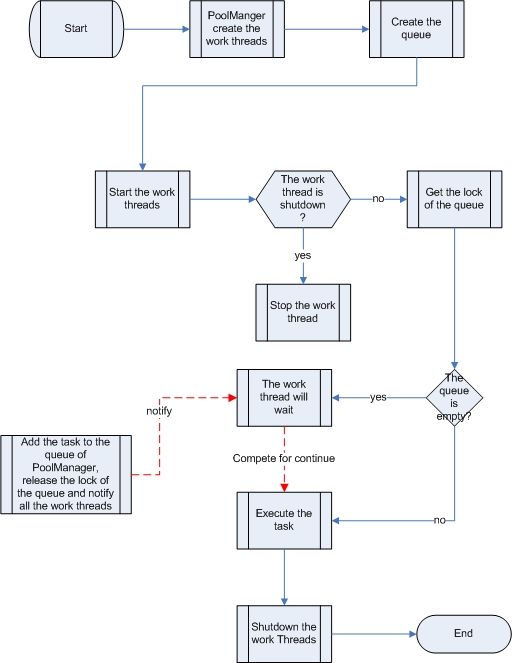为什么要建立线程池?
在多线程项目中,如果建立的线程过多,反而可能导致运行速度大大减慢,这是由于线程建立所花费的时间和资源都比较多。
所以我们在多线程中必须很好地来管理线程, 在很好利用多线程能“同步工作”的好处之外,更有效地提高程序运行速度。
线程池是什么?
线程池是指具有固定数量的线程组成的一种组件。这些线程用来循环执行多个应用逻辑。
怎么建立线程池?
线程池主要包括4个部分,它们是:
1. 线程管理
主要是用来建立,启动,销毁工作线程和把工作任务加入工作线程。
2. 工作线程
它是真正的线程类,运行工作任务。
3. 工作队列
它是用来封装线程的容器。
4. 工作任务
它是实现应用逻辑的具体类。
流程图:

线程管理类:
- <SPAN style="COLOR: #3366ff">import java.util.ArrayList;
- import java.util.List;
- import java.util.Queue;
- import java.util.concurrent.ConcurrentLinkedQueue;
- /**
- * ThreadPoolManager.java
- *
- */
- /**
- * the thread pool manager, is responsible for starting and stopping the work thread.
- *
- * @author gray
- * @version 1.0
- */
- public class ThreadPoolManager {
- private static final int DEFAULT_POOL_SIZE = 4;
- private List<WorkThread> threadPool;
- private Queue<Task> taskQueue;
- private int poolSize;
- public ThreadPoolManager() {
- this(DEFAULT_POOL_SIZE);
- }
- public ThreadPoolManager(int poolSize) {
- if(poolSize <= 0) {
- this.poolSize = DEFAULT_POOL_SIZE;
- }else {
- this.poolSize = poolSize;
- }
- threadPool = new ArrayList<WorkThread>(this.poolSize);
- taskQueue = new ConcurrentLinkedQueue<Task>();
- startup();
- }
- public void startup() {
- System.out.println("start work thread...");
- synchronized(taskQueue) {
- for(int i = 0; i < this.poolSize; i++) {
- WorkThread workThread = new WorkThread(taskQueue);
- threadPool.add(workThread);
- workThread.start();
- }
- }
- }
- public void shutdown() {
- System.out.println("shutdown work thread...");
- synchronized(taskQueue) {
- for(int i = 0; i < this.poolSize; i++) {
- threadPool.get(i).shutdown();
- }
- System.out.println("done...");
- }
- }
- public void addTask(Task task) {
- synchronized(taskQueue) {
- taskQueue.add(task);
- taskQueue.notify();
- }
- }
- }</SPAN>
import java.util.ArrayList;
import java.util.List;
import java.util.Queue;
import java.util.concurrent.ConcurrentLinkedQueue;
/**
* ThreadPoolManager.java
*
*/
/**
* the thread pool manager, is responsible for starting and stopping the work thread.
*
* @author gray
* @version 1.0
*/
public class ThreadPoolManager {
private static final int DEFAULT_POOL_SIZE = 4;
private List<WorkThread> threadPool;
private Queue<Task> taskQueue;
private int poolSize;
public ThreadPoolManager() {
this(DEFAULT_POOL_SIZE);
}
public ThreadPoolManager(int poolSize) {
if(poolSize <= 0) {
this.poolSize = DEFAULT_POOL_SIZE;
}else {
this.poolSize = poolSize;
}
threadPool = new ArrayList<WorkThread>(this.poolSize);
taskQueue = new ConcurrentLinkedQueue<Task>();
startup();
}
public void startup() {
System.out.println("start work thread...");
synchronized(taskQueue) {
for(int i = 0; i < this.poolSize; i++) {
WorkThread workThread = new WorkThread(taskQueue);
threadPool.add(workThread);
workThread.start();
}
}
}
public void shutdown() {
System.out.println("shutdown work thread...");
synchronized(taskQueue) {
for(int i = 0; i < this.poolSize; i++) {
threadPool.get(i).shutdown();
}
System.out.println("done...");
}
}
public void addTask(Task task) {
synchronized(taskQueue) {
taskQueue.add(task);
taskQueue.notify();
}
}
}
工作线程类:
- <SPAN style="COLOR: #3366ff">import java.util.Queue;
- /**
- * WorkThread.java
- *
- */
- /**
- * the work thread used pull the task of task queue, and execute it.
- *
- * @author gray
- * @version 1.0
- */
- public class WorkThread extends Thread {
- private boolean shutdown = false;
- private Queue<Task> queue;
- public WorkThread(Queue<Task> queue) {
- this.queue = queue;
- }
- public void run() {
- while(!shutdown) {
- try {
- Thread.sleep(1000);
- } catch (InterruptedException e1) {
- e1.printStackTrace();
- }
- System.out.println(Thread.currentThread() + " is running...");
- synchronized(queue) {
- if(!queue.isEmpty()) {
- Task task = queue.poll();
- task.execute();
- }else {
- try {
- queue.wait(1000);
- System.out.println(Thread.currentThread() + " wait...");
- }catch(InterruptedException e) {
- }
- }
- }
- }
- }
- public void shutdown() {
- shutdown = true;
- }
- }</SPAN>
import java.util.Queue;
/**
* WorkThread.java
*
*/
/**
* the work thread used pull the task of task queue, and execute it.
*
* @author gray
* @version 1.0
*/
public class WorkThread extends Thread {
private boolean shutdown = false;
private Queue<Task> queue;
public WorkThread(Queue<Task> queue) {
this.queue = queue;
}
public void run() {
while(!shutdown) {
try {
Thread.sleep(1000);
} catch (InterruptedException e1) {
e1.printStackTrace();
}
System.out.println(Thread.currentThread() + " is running...");
synchronized(queue) {
if(!queue.isEmpty()) {
Task task = queue.poll();
task.execute();
}else {
try {
queue.wait(1000);
System.out.println(Thread.currentThread() + " wait...");
}catch(InterruptedException e) {
}
}
}
}
}
public void shutdown() {
shutdown = true;
}
}
工作任务接口:
- <SPAN style="COLOR: #3366ff">/**
- * Task.java
- *
- */
- /**
- * The task want to execute.
- *
- * @author gray
- * @version 1.0
- */
- public interface Task {
- public void execute();
- }</SPAN>
/**
* Task.java
*
*/
/**
* The task want to execute.
*
* @author gray
* @version 1.0
*/
public interface Task {
public void execute();
}
工作任务类:
- <SPAN style="COLOR: #3366ff">/**
- * SimpleTask.java
- *
- */
- /**
- * @author gray
- * @version 1.0
- */
- public class SimpleTask implements Task {
- /* (non-Javadoc)
- * @see Task#execute()
- */
- public void execute() {
- System.out.println(Thread.currentThread());
- }
- }</SPAN>
/**
* SimpleTask.java
*
*/
/**
* @author gray
* @version 1.0
*/
public class SimpleTask implements Task {
/* (non-Javadoc)
* @see Task#execute()
*/
public void execute() {
System.out.println(Thread.currentThread());
}
}
线程池测试类:
- <SPAN style="COLOR: #3366ff">/**
- * ThreadPoolDemo.java
- *
- */
- /**
- * @author gray
- * @version 1.0
- */
- public class ThreadPoolDemo {
- public static void main(String[] args) {
- ThreadPoolManager threadMg = new ThreadPoolManager();
- for(int i = 0; i < 50; i++) {
- threadMg.addTask(new SimpleTask());
- }
- try {
- Thread.sleep(5000);
- } catch (InterruptedException e) {
- e.printStackTrace();
- }
- threadMg.shutdown();
- }
- }</SPAN>

























 90
90

 被折叠的 条评论
为什么被折叠?
被折叠的 条评论
为什么被折叠?








